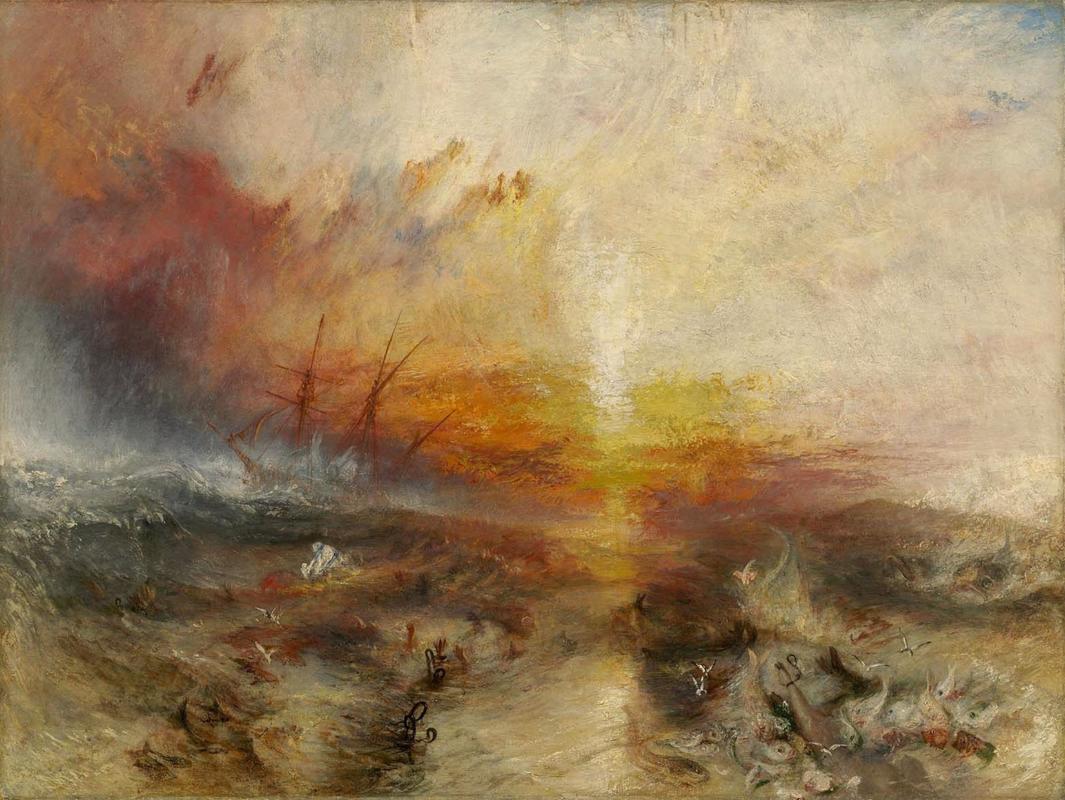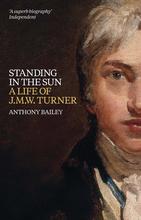More about Slave Ship
- All
- Info
- Shop

Sr. Contributor
J. M. W. Turner’s The Slave Ship depicts a historical event that makes 12 Years a Slave seem like Disney's Song of the South.
Before movies like Amistad and the TV Series Roots, those seeking to visually represent the horrors of slavery had to rely on the paintbrush. Originally titled Slavers throwing overboard the Dead and Dying, Typhoon coming on, the painting shows the chained, indistinct fragments of African bodies being devoured by fanciful sea monsters as a ship sails into a storm.
Turner was inspired by the real life Zong Massacre. The British ship Zong set sail from Africa overloaded with slaves in 1781. When the ship sailed off course and water allegedly grew scarce, the crew abided by the age-old law of the sea: women and children first. Unfortunately, in this case that didn’t refer to lifeboats. They started by forcing 54 female and child slaves through portholes into the sea, probably because they were less valuable than adult males. In the ensuing holocaust that lasted several days, 142 people were thrown overboard, including 10 who jumped in protest. After the first wave of killings, remaining victims begged the crew to starve them rather than dump them into the ocean, but the crew didn’t comply because they couldn’t collect insurance on slaves who died of natural causes.
Upon reaching shore (with 420 imperial gallons of the supposedly dwindling water), the crew attempted to file an insurance claim on the murdered slaves. The courts ultimately ruled against them, not because of the atrocities they had committed, but because they were negligent and mismanaged their cargo. When abolitionists tried to press criminal charges, the British Solicitor General dismissed them. He said that no “human people” had been jettisoned, and that it was “madness to accuse these well-serving honorable men of murder…the case is the same as if wood had been thrown overboard.”
Turner painted The Slave Ship in 1840 as a propaganda piece, hoping it would catch the attention of Prince Albert at the British Anti-Slavery Conference. Instead, it caught the attention of critic John Ruskin, who bought the painting. Ruskin is famous for his sycophantic fawning over Turner’s work, as well as for refusing to have sex with his own gorgeous wife Effie Gray because she had pubic hair. Effie responded by running off and having plenty of sex with Pre-Raphaelite painter John Everett Millais, who was not so picky about landscaping. Ruskin evidently had a more astute eye for painting than he did for women.
175 years later, Turner’s The Slave Ship is fresh in the zeitgeist. The Zong court case is a major plot point in films like Belle (2013), Mr. Turner (2014), and Effie Gray (2014). Belle stars Gugu Mbatha-Raw in an Oscar-snubbed performance as the biracial subject of a famous portrait by Johann Zoffany. In Mr. Turner, Timothy Spall of Harry Potter fame plays the title artist in a richly textured biopic. The cast includes Joshua McGuire as Slave Ship owner John Ruskin, who plays him to perfection as the most insufferable of Victorian hipsters. Emma Thompson’s Effie Gray also features Ruskin, played by Greg Wise opposite Dakota Fanning as his sex-starved wife.
Featured Content
Here is what Wikipedia says about The Slave Ship
The Slave Ship, originally titled Slavers Throwing overboard the Dead and Dying—Typhon coming on, is a painting by the British artist J. M. W. Turner, first exhibited at The Royal Academy of Arts in 1840.
Measuring
35+3⁄4 in × 48+1⁄4 in (91 cm × 123 cm) in oil on canvas, it is now on display at the Museum of Fine Arts, Boston. In this classic example of a Romantic maritime painting, Turner depicts a ship visible in the background, sailing through a tumultuous sea of churning water and leaving scattered human forms floating in its wake. Turner was possibly moved to paint The Slave Ship after reading about the slave ship Zong in The History and Abolition of the Slave Trade by Thomas Clarkson the second edition of which was published in 1839. The initial exhibition of the painting in 1840 coincided with international abolitionist campaigns. As the piece changed hands in subsequent years, it was subject to a wide array of conflicting interpretations. While the work is generally admired for its spectacular atmospheric effects, there are conflicting opinions about the relationship between its style and its subject matter.
Check out the full Wikipedia article about The Slave Ship



















Apart from being anti-slavery propaganda depicting the Zong massacre, The Slave Ship also reveals the sublime-ness of nature. The concept of the sublime, popularized by Edmund Burke, can be described as a sort of astonishment: a sort of stop-you-in-you-tracks moment, a moment of reveling in the sensations of terror, passion, and grandeur. Notice in Turner’s painting, the scale of the ship and people in the water, compared to the sea and sky. The elements of sea and sky are vast and emotive in their size and color; it is easy to see that a storm is brewing, that nature is taking over. The sky holds a dangerous vibrancy in the clouds and passion invoking colors. The sea is tumultuous and dark, featuring frightful white caps as well as still-chained slaves being picked over by fish. Nature is essentially consuming the painting: consuming the ship, consuming the slaves, and stopping the viewer in their tracks in a contemplation of terror. This astonishing effect, is after all, what the sublime is wont to do.